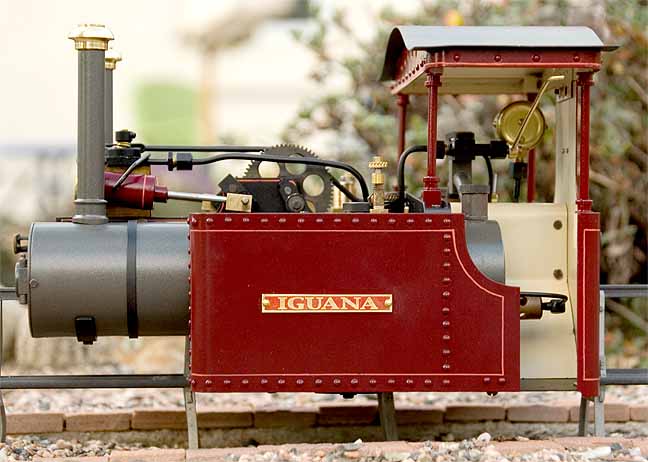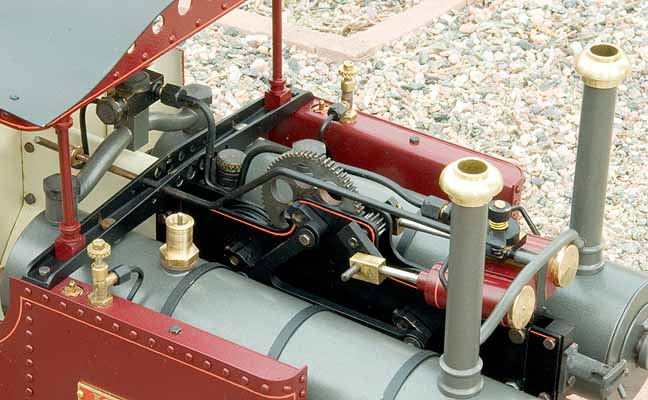
Back to Loco of the Month homepage
Back to Sidestreet Bannerworks
.
April 2008
Lizard Valley's Iguana
by Marc Horovitz

This is a freelance model, so has no history, per se. However, the system on which it is based does have a history. It is the brain child of Charles Francois Marie-Therese Lartigue, a French engineer of the late 1800s. He was reportedly inspired by the sight of a train of camels walking along the horizon, which gave him the idea of his monorail system, fully formed. The camels' legs represented the track, their bodies the train, and their packs the cargo.
He developed his system and built some test railways, including an animal-hauled line in Algeria, a couple of electric exhibition lines in France, and even a steam-powered demonstration railway in London. The latter had an engine with twin vertical boilers. However, his big (and only) break came with the Listowell & Ballybunion Railway in southern Ireland. This was a full-blown development of his ideas. The railway, which opened in 1888, was around nine miles long. It was originally intended to carry sand, but ultimately carried passengers and all kinds of freight. Astonishingly, the line lasted almost 40 years. There are two or three good books out there that tell the whole story.
The track is built using A-frames, atop which is mounted the single rail. There are a pair of stabilizing rails, one on each side, that do not bear weight. Locomotives and rolling stock have stabilizing wheels that bear on these rails and which help to keep the train level with respect to the track. A full system of switches, grade crossings, and turntables was developed as well.
The Lartigue system's chief asset was that it was relatively cheap to build. However, when that is weighed against its many liabilities, it's small wonder that the concept didn't see wider use.
The model
I've always been interested in the odd and unusual when it comes to railway matters, so I was naturally attracted by the Lartigue monorail. I am not the first, however, to explore it. John Ponting in England has also built at least two live-steam monorail locomotives in this scale. I've seen them, though not running.
I didn't want to build a model of the Listowell engines. These were built by Hunslet to a design by Anatole Mallet and were 0-3-0 tender engines with steam boosters in the tender. I preferred the freelance approach, hence Iguana.
The track is designed using the same proportions employed in Ireland. Larry Herget, then of Ozark Miniatures, cast several hundred A-frames for me from a pattern that I supplied him. These were done in soft white metal. I built the track using these A-frames and code-196 brass rail. I had to make a rail bender that would put a vertical curves into the stabilizing rails as well as horizontal ones in the running rail. The A-frames are mounted on a wood substructure, which is buried in the ballast. The line measures approximately 60 feet and is point-to-point in plan, with one terminal at Ogden and the other at Lizard Westen. It interchanges with the Ogden Botanical Railway at both locations. The Lizard Valley Steam Monorail Company gets its name from a local rock formation that forms one side of the valley and is said to resemble a lizard in repose.
I designed the locomotive to be relatively easy to build, since I didn't want a huge time investment in something that might or might not work. Thus, I chose an oscillating steam motor similar to those I used in my tram engines (although the monorail engine was built first). This is geared around 5:1 to a large gear that is, in turn, connected to the drivers via side rods (the engine is an 0-2-0). The frame is a pair of plates. Boiler supports are attached to the front end and the stabilizing-wheel assemblies are also fastened to the frames near the rear of the engine.
Boilers are both functional and are conventional, single flue, gas-fired units. Each side tank holds a small butane reservoir. The boilers are connected by a manifold pipe, creating, in essence, a single pressure vessel, so only one safety valve is necessary. The throttle and other steam fittings are fitted to the middle of the manifold pipe in the cab. All body work is sheet steel.
It was my intention to scratchbuild everything possible on this locomotive. The only things I didn't make are the gas-filler valves (I did make the control valves), the gas jets, the gears, and the pressure gauge. I even learned a little about metal etching to make the name plates.
I vividly recall the first steam test, which was conducted on my work bench. If the engine is sitting on the bench, not on the track, the mechanism is free floating and needs no further support to operate in a stationary manner. I prepared the engine in the usual way and lit the boilers through the hinged smokebox doors. As I was waiting for pressure to build, the photo rang. I got involved with the phone call and forgot everything else (as I have a tendency to do these days). Part way through the call I heard a sound in the shop I couldn't identify. Upon investigation, I discovered that it was the engine, happily running all by itself. I'd left the throttle open and when pressure came up, it just went!
The run
The next thing to do was to try it on the track. I had built some coaches a few years before but had nothing to pull them. I placed the engine on the track with a couple of coaches. This is a little tricky because all of the stabilizing wheels, which are double flanged like the driving and riding wheels, have to properly engage the stabilizing rails.
Once all was good, I lit up the engine and waited for pressure to build. When it came up, I opened the throttle, and the train departed, just like that. Since it was geared down, the engine speed was not excessive. I ran to the other end of the line to meet the train and shut it down. I was surprised (and gratified) that it backed down the track just as smoothly. It ran very well for about 20 minutes, until the gas was exhausted. I was delighted.
For the purpose of filming the monorail, I installed an R/C servo in the roof that controlled the throttle only. My daughter Adriane ran the camera while I ran the train, reversing it manually at either end. If you'd like to see it run, click here. If that doesn't work, you can also see it on YouTube. (Apologies for the quality on YouTube -- I'm still feeling my way with this technology. I'll repost a better copy if I can figure out how to do it.)
So, the engine was complete but unpainted. Painting for me is an agony that I always put off as long as I can. Four years later I finally bit the bullet and did the job. It took about three weeks, but it is finally finished.
Sadly, though, it may never run again. During the winter of 2006-07 we had a tremendous amount of snow, one storm after another. The Lizard Valley slowly filled with snow and ice. When the spring thaw finally came I was dismayed to find about a third of the track had been crushed under the successive layers. I have no more A-frames, nor would I want to use the same metal again anyway. The two ends of the railway still exist, and may have to serve as reminders of what had been.
|
|
|
| Builder | Marc Horovitz (US) |
| Date built | 2003 (painted 2007) |
| Gauge | Monorail |
| Scale | 16mm |
| Boiler | (Two) single flue |
| Fittings | Safety valve (1), pressure gauge, throttle |
| Fuel | Butane |
| Blow-off pressure | 45 psi |
| Cylinders | Two, double-acting oscillators |
| Reversing gear | Rotary valve |
| Lubricator | Displacement |
| Weight | 4 pounds, 8 ounces |
| Dimensions | Length, 8": width, 5-3/4"; height, 5 3/4" |






The staircase behind the locomotive is actually a special car built into the train that allowed people to climb over the track.






Back to Loco of the Month home page
Back to Sidestreet Bannerworks home page
This page and its contents
Copyright Sidestreet Bannerworks, 2008
.